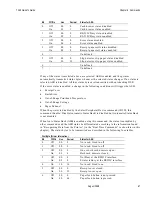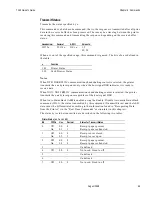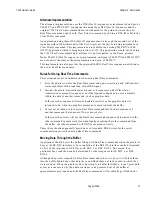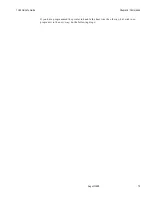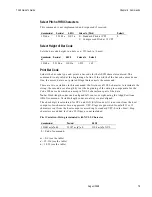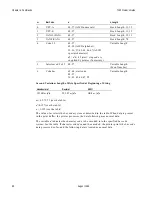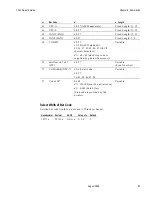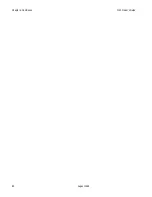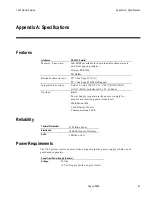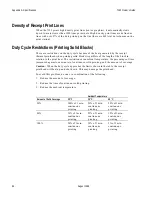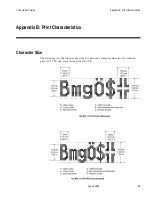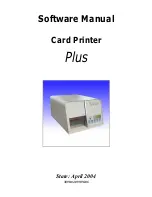
Chapter 6: Commands
7193 Owner’s Guide
August 1998
72
When the printer is busy due to an error condition, then data stops being processed of the
buffer until the condition clears one way or another. In either case, but more quickly in the
case of an error condition, the buffer can fill with Real Time commands.
When the DLE sequences are being used, the last byte stored when the buffer fills up could
be the DLE code, with no room for the subsequent EOT or ENQ. When this lone DLE byte
is finally processed out of the buffer it will be interpreted as a Clear Printer command.
Similarly, when the GS sequences are being used, the last byte stored when the buffer fills
up could be the GS code, with no room for the subsequent EOT or ETX or ENQ. When this
lone GS byte is finally processed out of the buffer it will use the next byte, whatever it is, as
the second byte in its GS sequence.
To guard against this situation, the application must determine the cause of a busy
condition and take appropriate action or pace the Real Time commands to avoid filling the
buffer. There are a minimum of 256 bytes available in the printer’s buffer when it goes
busy.
Busy Line and Fault Conditions
An additional improvement is made in the way the 7193 RS-232C handles the busy line (or
busy condition when using XON/XOFF) during a fault condition.
Before this improvement, the printer would go busy at the RS-232C interface when the
receipt door was opened or the paper was exhausted as soon as it received the next input
byte. Bytes would continue to be accepted until the buffer was full or the condition was
cleared, but would stop processing data out of the receive buffer. This resulted in the
printer being unable to respond to the batch mode status commands (ESC v and ESC u), or
handle the cash drawer commands even when it was not printing.
The improvement overcomes this limitation by not going busy at the RS-232C interface
until it attempts to process a command out of the receive buffer which it can't do: for
example, print on the receipt when it's out of paper. It will stay busy and stop processing
data out of the receive buffer until the condition clears.
Now if the cover is open or the paper is exhausted, the 7193 printer will still accept data,
respond to the batch mode status commands (ESC v and ESC u), handle the cash drawer
commands, and not go busy until it actually tries to execute a print command. Then it will
stay busy and stop processing data out of the receive buffer until the condition clears. It
will respond to the Real Time commands as described below.
The only potential backward compatibility issue is if some application expects the 7193 to
go busy when it processes a batch mode status command, which it now won't. To handle
this case, there is now a parameter setup in NVRAM to have the printer handle the busy
line the old way. The default will be the new way, but the printer can be programmed in
the field if it proves to be a problem.
To program the printer to handle the busy line the old way do the following steps:
1.
Record the current switch settings for their RS-232C parameters.
2.
Set switches 2 and 3 to OFF, and set switches 1, 4, 5, and 6 to ON.
3.
Power cycle the printer.
4.
Wait until the printer beeps to store the parameter change in NVRAM.
5.
Restore the switches to their RS-232C parameters.
6.
Power cycle the printer.
7.
Print out the diagnostics to be sure that the busy line parameter changed.
Summary of Contents for 7193
Page 1: ...BD20 1439 A Issue B August 1998 NCR 7193 Thermal Receipt Printer Owner s Guide ...
Page 6: ...Contents 7193 Owner s Guide August 1998 x ...
Page 16: ...Chapter 2 Setting Up the Printer 7193 Owner s Guide August 1998 10 Parallel Models ...
Page 22: ...Chapter 2 Setting Up the Printer 7193 Owner s Guide August 1998 16 ...
Page 24: ...Chapter 2 Setting Up the Printer 7193 Owner s Guide August 1998 18 ...
Page 26: ...Chapter 2 Setting Up the Printer 7193 Owner s Guide August 1998 20 ...
Page 30: ...Chapter 3 Solving Problems 7193 Owner s Guide August 1998 24 ...
Page 48: ...Chapter 5 Communication 7193 Owner s Guide August 1998 42 ...
Page 88: ...Chapter 6 Commands 7193 Owner s Guide August 1998 82 ...
Page 96: ...Appendix B Print Characteristics 7193 Owner s Guide August 1998 88 ...
Page 102: ...Index 7193 Owner s Guide August 1998 94 ...
Page 103: ......










